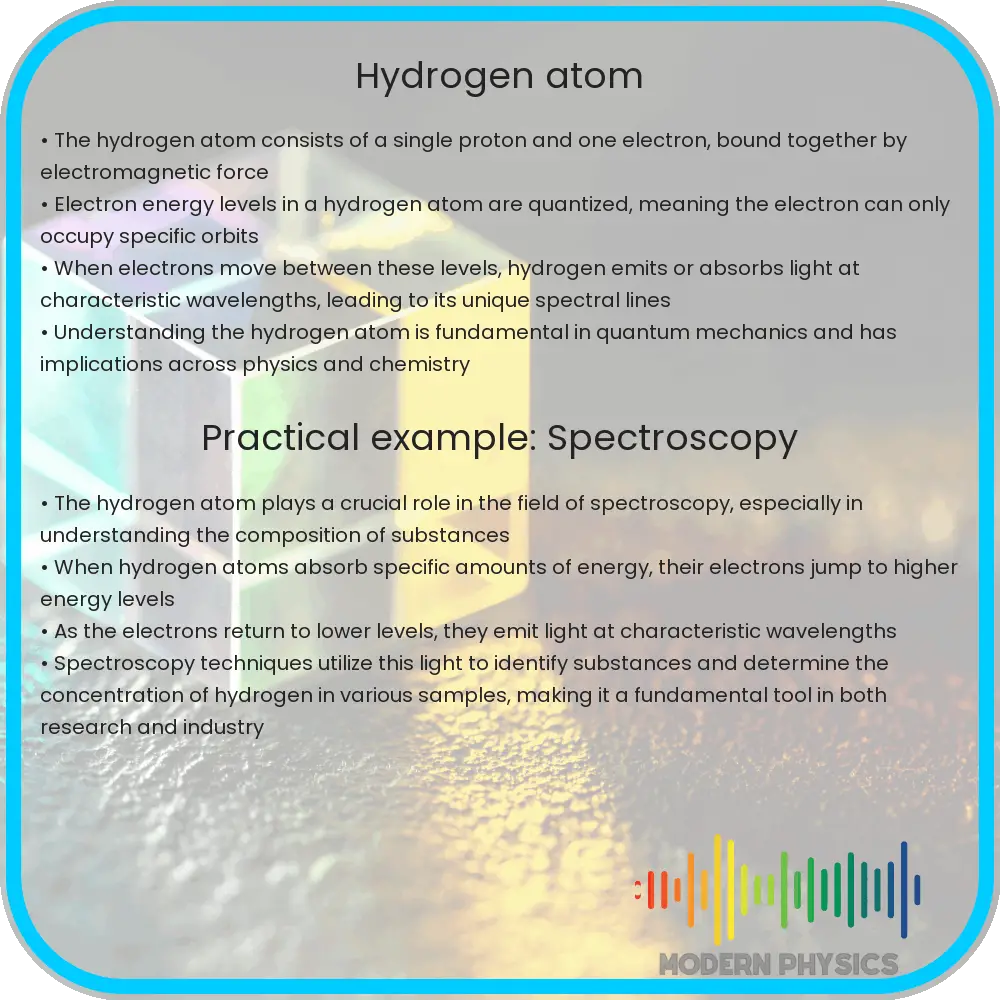Unraveling the hydrogen atom, this article delves into its simple structure, quantum mechanics, and significance across multiple scientific and technological domains.

Introduction to the Hydrogen Atom
The hydrogen atom is the simplest and most abundant atom in the universe, consisting of only one proton and one electron. This simplicity makes it a fundamental building block in chemistry and physics, providing a basis for understanding more complex atoms and molecules. The study of the hydrogen atom not only sheds light on atomic structure and quantum mechanics but also plays a crucial role in fields ranging from astronomy to energy research.
The Structure of the Hydrogen Atom
At the heart of the hydrogen atom is its nucleus, which contains a single proton. Orbiting this nucleus is one electron, held in place by the electromagnetic force between the negatively charged electron and the positively charged proton. This interaction is described by quantum mechanics, which provides a probabilistic model rather than a definitive orbit like the planets around the sun.
Quantum Mechanical Model
Unlike the orbits of planets, the position of an electron in a hydrogen atom is not defined by a clear path. Instead, quantum mechanics uses the concept of orbitals — regions in space where there is a high probability of finding an electron. The simplest of these is the s-orbital, which is spherical around the nucleus.
The energy levels of an electron in a hydrogen atom are quantized, meaning the electron can only exist in certain discrete energy levels, typically denoted as En where n represents the principal quantum number. The energy levels are given by the formula:
En = -13.6 eV / n2
Here, -13.6 eV is the energy of the electron in the ground state (n=1), and the energy increases (becomes less negative) as n increases.
Electron Transitions and Spectral Lines
When an electron in a hydrogen atom transitions between energy levels, it either absorbs or emits a photon with energy equal to the difference between these levels. This is described by the formula:
E = h * f
where E is the energy of the photon, h is Planck’s constant, and f is the frequency of the photon. Each of these transitions results in a spectral line, unique to hydrogen, known as the Lyman, Balmer, and Paschen series, among others, which appear in different regions of the electromagnetic spectrum.
Importance of the Hydrogen Atom in Science and Technology
The hydrogen atom plays a pivotal role in various scientific and technological fields. In astronomy, the spectral lines of hydrogen help astronomers determine the composition of stars and galaxies. In energy research, hydrogen is considered a potential cleaner fuel alternative, promising a reduction in pollution compared to fossil fuels. Understanding the hydrogen atom is also crucial for the development of quantum mechanics, influencing modern technologies like semiconductors and quantum computers.
In the following sections, we will explore more deeply how the study of hydrogen has contributed to quantum mechanics and other areas of physics, along with its practical applications in technology and energy solutions.
Hydrogen and Quantum Mechanics
One of the most profound implications of studying the hydrogen atom comes from its role in the development of quantum mechanics. The peculiar behavior of the electron within a hydrogen atom, including its energy quantization and probabilistic location, played a significant role in shaping the early theories of quantum mechanics. These ideas have further led to the development of various applications, including lasers, transistors, and even MRI machines, all of which are fundamental to modern technology.
Hydrogen as an Energy Source
Hydrogen is also highly regarded as a future energy resource. It is touted for its abundance and potential in clean energy technologies. Hydrogen fuel cells, for example, generate electricity through a chemical reaction rather than combustion, producing only water as a byproduct. However, challenges such as efficient hydrogen production, storage, and transportation need to be addressed to fully utilize hydrogen as an alternative energy source. Continued study and understanding of hydrogen atoms may pave the way for innovative solutions to these challenges.
Educational Impact
The simplicity of the hydrogen atom makes it an excellent subject for educational purposes as well. It provides an accessible entry point for students diving into the complex world of atomic physics and quantum mechanics. Through the hydrogen atom, students can learn fundamental concepts such as atomic structure, electron configuration, and the nature of light and energy. This not only enriches the students’ understanding of the physical world but also sparks a curiosity that drives future scientific investigations.
Conclusion
The hydrogen atom, though simple, has a profound impact across various fields in science and technology. From aiding in the foundational development of quantum mechanics to its potential applications as a clean energy source, the ripple effects of understanding such a basic element continue to expand. As we advance our knowledge and tackle practical challenges in its application, hydrogen stands as a pivotal subject in both educational contexts and future technological innovations. Understanding and harnessing the properties of hydrogen could lead to significant advancements in energy, technology, and sustainability, marking its importance in both theoretical and applied sciences.
